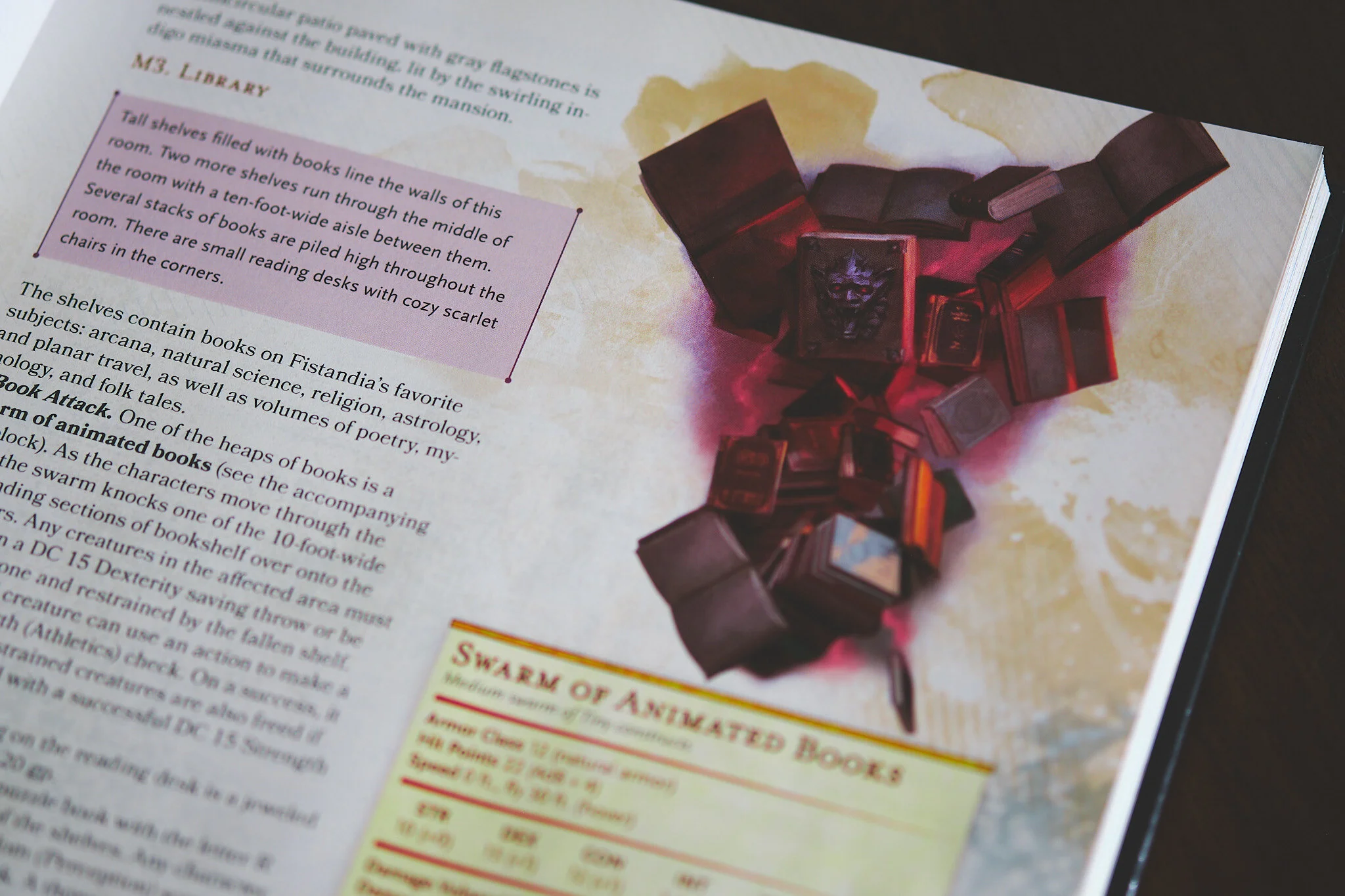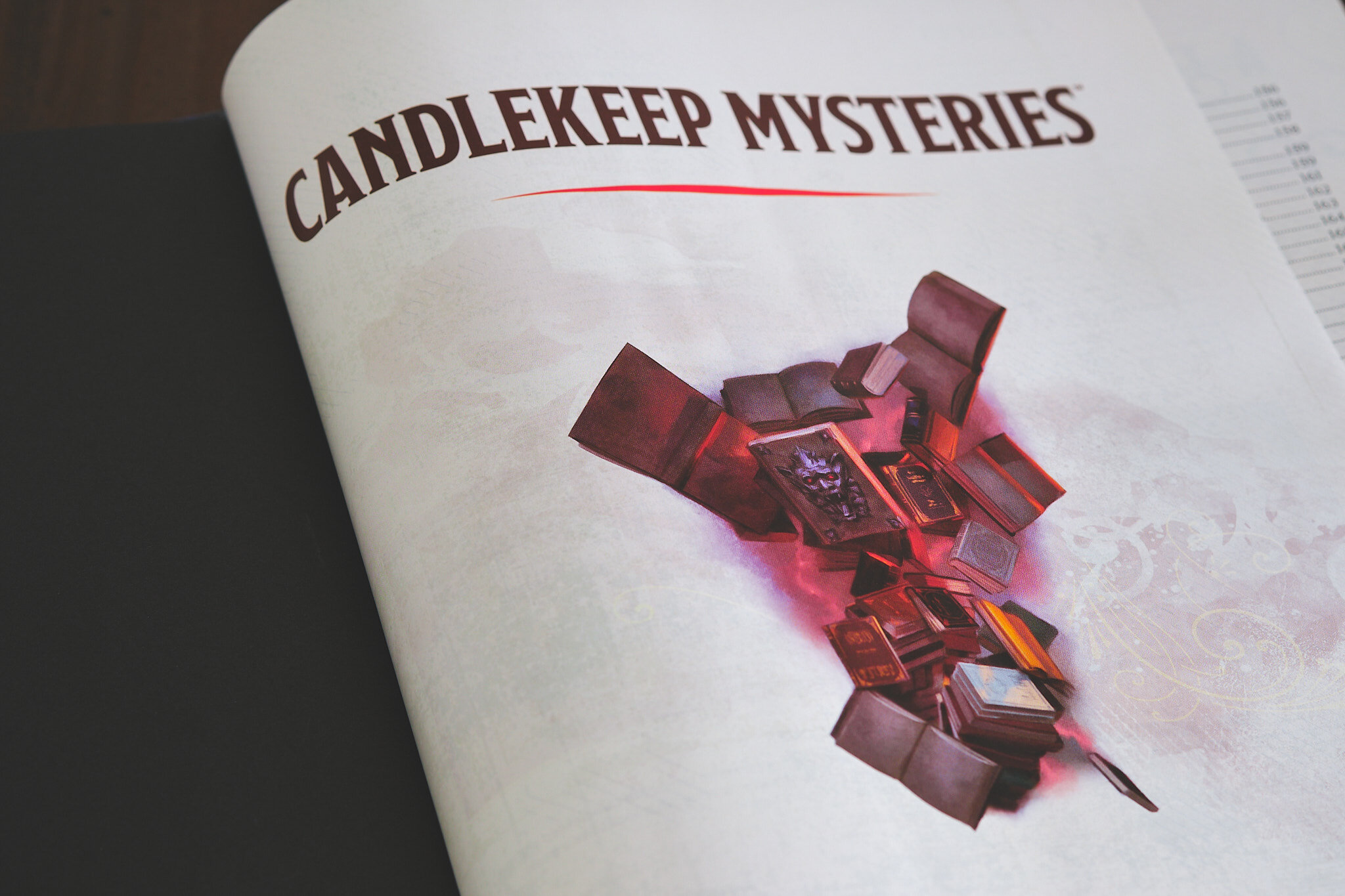The Joy of Extradimensional Spaces Review
We’ve wrapped up our first adventure in Candlekeep Mysteries, and now it’s time for a review of The Joy of Extradimensional Spaces (TJoEDS). In this episode, we reflect and share our thoughts on the first one shot in this new D&D adventure book.
Please note that this review might contain minor spoilers for players who haven’t completed this adventure.
QUICK SUMMARY
The Joy of Extradimensional Spaces is the first adventure in the Candlekeep Mysteries. It’s geared for a party of four to six 1st-level characters and takes between four to six hours to complete, depending on the party.
It is a standalone one-shot adventure that took us about four sessions (about an hour and a half each) to finish. Click here to listen to our live play of The Joy of Extradimensional Spaces.
The adventure starts with a request to the party to find one of Candlekeep’s adjuncts, Professor Matreous, who is slated to teach a course but has gone missing. After some sleuthing, the party will discover a portal to a Magnificent Mansion in Matreous’s Candlekeep study room, leading them into the meat of this campaign.
After stumbling into the mansion and finding Matreous, it’s then up to the party to find the command word to escape. However, this particular mansion belongs to a powerful wizard and not everything is as it seems…
Without spoiling too much, let’s talk about what made this adventure great, its sticking points, and how to tweak it to make it right for your table.
THE GOOD
Accessible adventures…
Having a book full of concise one-shot adventures has been a great boon for time-strapped players and DMs who want to play consistently. Don’t get us wrong, we love to write campaigns, storylines and build new worlds.
But, the reality for us is we’ve got full-time jobs, families, and other things that pull us away from coveted tabletop time. Having a quality D&D 5e book full of bite-sized adventures takes a lot of the load off from prepping and lets us play without a huge investment.
Flexible story hooks for DMs…
The book does a great job at giving you flexible story hooks and ways to integrate the party into the story. Sometimes it can feel awkward pulling the party into a new adventure, so having some prewritten options to guide you or spark some ideas is extremely helpful. There’s a ton of lore around Candlekeep and its denizens, which also presents ample opportunities for DMs to build and expand on for your campaign.
New DM-Friendly NPC list…
Speaking of DMing, the NPC list for this campaign is relatively short, making it friendly for newer DMs who might not have a lot of experience managing multiple NPCs. Combined with the Candlekeep lore of how these people and creatures behave will give you a strong foundation to stand on when presenting these NPCs to your players.
Lore galore…
Fistandia’s Mansion is full of interesting lore and artifacts the party can interact with and explore. The mansion layout and design are very concise and good for new adventurers. However, there are some areas that can be improved which we’ll get into later.
As a DM, it was a ton of fun seeing the party methodically explore each part of the mansion to uncover clues. And whether you go off the book’s lore only or supplement your own, your party will have a blast poking around. Until inanimate objects take a bite out of them, of course.
Interesting encounters…
And since we’re on combat, the encounters in this are a little unconventional, but fun. Most, if not all, of the encounters are surprises. This can be a little frustrating for new players, which we’ll talk about later.
But after the first few random objects attack the party, they might take a different approach to exploration (mainly by smashing things - you know how it goes). The party will get to battle some monsters and objects they might not have encountered before, but will remember afterward!
Cool magic reward…
Speaking of which, the magic item reward for this adventure is AWESOME. After fisticuffs with a particularly jealous chained library, the party can sift through its remnants to find an improvised book weapon. It’s title is “Martial Attack Techniques” and serves as a +1 magical flail.
I love this because it’s the kind of silly-but-fun stuff I put in my games. The Lizardfolk Paladin in our party made great use of her new toy to great roleplaying effect.
THE BAD
The book does a fantastic job of looping the players into the story and providing a rich setting for the players to explore. However, it’s not without its shortcomings. We’re not trying to be overly critical, but rather to help identify where this adventure can benefit from some strengthening or pre-planning for your game.
Potential sticking points…
Hooking the party into the story was relatively easy with the building blocks the book gives you. And thankfully, getting the party into the mansion also isn’t too much of a problem. After the party gets inside and finds the professor, however, things have the potential to get tricky.
Here’s an example. When the party first enters the mansion, they find their initial goal immediately - the professor. This NPC asks the party to find the exit passphrase and any other treasures they might discover, like the imp figurine he found, before leaving to teach his course.
Just as the portal closes, the party hears him scream as the imp figurine he found transforms into an actual imp and stings him. This traps the players with some urgency to escape quickly. But, what if the party decides to extract the professor and leave with him?
Because this is a critical juncture in the adventure, it’s up to the DM to have the improv skills to redirect the party. Do this by creating scenarios enticing them to stay and explore.
The cleric in our party was hesitant to get stuck in the mansion like the professor did, not trusting him to let them out later. Because wizards tend to be a little, well you know, flighty.
How to resolve it…
Seeing this as a potential sticking point, I had the professor promise to have the handler keep the portal open to ease their minds.
Of course, they had no idea about the imp on the other side, so I was still able to lock the party in the mansion without any hiccups. The imp in this case disabled the professor and the handler to prevent them from reopening the portal on their side. Thus, they had no choice but to quickly find the command word to escape the mansion.
Lots to do in the study…
Running the adventure as written, the mansion’s study is the first major room the party will most likely explore. There are a few really important things about this room, but that can be quickly derailed by a simple house cat.
In the book, when the party enters certain rooms a cat will jump up from its slumber to greet them. When your table is playing a mystery game, they might think it’s some kind of clue (as our table did). And they’ll try to figure out what secrets this feline holds (spoiler alert: it’s none).
While not necessarily a bad thing, this distraction (which I believe was intentional from the writer) did pull the party away from that room and into another. This left some confusion about what was done and explored in that study.
And while our table didn’t have the ability to speak with animals, a differently specced party might be able to approach things in another way.
One of the challenges we had with the study was how much information to give for certain checks. A player taking time to explore the study room will figure out some important information. This includes who owns the mansion, how it came to exist, and that the owner hid the exit phrase on seven books throughout the mansion.
However, an investigation check will reveal a secret passage to one of those puzzle books. But what happens if the party biffs that investigation check?
How to resolve it…
The book doesn’t offer much help here, but there are a few ways to handle it. While the ranger missed the investigation check, the paladin was able to step in with a different approach. This involved breaking a lot of things, which ended up uncovering the hidden passage.
Having these kinds of backup plans for when the party fails on critical campaign discoveries will help new and veteran DMs navigate these friction points.
Lack of clues & Perception vs. Investigation…
Also in this vein, the lack of connective tissue between clues and solutions for puzzles leaves gaps that can frustrate players and leave new DMs scrambling. It’s helpful to understand the difference between passive perception, perception checks, and investigation checks. Perception is one’s ability to notice something’s potentially off.
Investigation lets you piece things together to form a lead or discovery. The book does not do a great job at giving you the linkages between clues and puzzles that could help your players create a more rewarding fact-finding mission. Instead, players are left to roll dice at their problems. Where the book does add some extra clues, it is mostly around the lore of the mansion and does not help the party advance the quest.
One thing I’m taking away is more awareness of perception checks revealing clues for better investigation opportunities. My goal is to do this in a way that makes the party feel accomplished in their efforts.
Easy puzzles don’t challenge players…
And since we’re on the topic of clues and puzzles, it’d be prudent to go over the ones in this adventure. The main puzzle in this campaign is a simple spelling game: find the letters and unscramble them to find the passphrase, which is fine. There are enough letters, encounters, and distractions to make that feel fun. However, the other puzzles are either too easy or obtuse to really engage the party.
The main one that comes to mind is the puzzle in the observatory. The solution, which is in the room the party visits immediately before the observatory, is so obvious that it completely overshadows the interesting room the writer created in this mansion.
As we reflected, we thought a more engaging approach would be to hide that clue in a different part of the mansion. This would make the party think a little more or have some other method set up for the party to reconcile or discover the solution.
Difficult encounters for 1st-level groups…
We ran this campaign with a party of three level 2 adventurers; a cleric, paladin, and ranger. The additional level helped balance some of the encounters with the smaller party size. But, as the DM I still made the call to pull some encounters to streamline and balance the campaign.
As we reflected, the group agreed that the encounters were fairly difficult for a level 1 party. As I mentioned, I pulled some encounters and dialed some back a little to preserve the players and keep the game moving while wearing the team down.
However, the number of invisible creatures and surprise attacks in this adventure could easily catch new and seasoned adventurers off guard. Especially if they don’t have the ability to detect these creatures.
It can be frustrating for a careful party to be surprised by that bookshelf that bopped you or that chaise lounger that took a bite out of your leg. But, understand that’s just part of the adventure. Some fun alternatives for a more roleplaying focused party would be to turn those enemies into engaging NPCs that help or hinder the party in creative ways.
Tunnel vision…
Once the party figures out the puzzle to solve, they can forget to look for other cool stuff. While the main objectives were checked and some cool loot found, there were still a few stones left unturned. As a DM, I want the players to feel like they can take their time to explore. But, in this case, the desire to escape overshadowed the need to pillage and plunder.
THE +1s
I ran this adventure mostly by the book, but with a few adjustments. I want to share the changes I made to help give you some idea for your game or other adventures you’re running. And to avoid confusion for those listening to our live play.
Killing off the Professor…
As written, Professor Matreous dies when he’s stung by the imp. I felt that a rather harsh end to an otherwise kindly old man, and gave the party an opportunity to save him and the handler they were assigned. It’s a much tidier end to the story and gives extra reward opportunities and story hooks to parties that make the effort.
One way to give them this opportunity was to allow the party to find some form of antitoxin while in the mansion. Levo, the party’s lizardfolk paladin, discovered some plants that had anti-venom properties and was able to use them to revive the professor and handler.
Sure, the rolls were fast and loose, but I wanted to emphasize the party doing cool stuff and figuring out unique solutions to their problems above everything else.
Failing the secret door investigation check...
In the study, there is an alchemy lab below it that is accessible through a secret bookcase door. It’s revealed with a low investigation DC, but there’s still a chance to fail this important check. For new DMs, here’s a tip: always have more than one way to get through a challenge.
Something as simple as, “The party can detect a faint hint of chemicals wafting from the bookcase…” will suffice if they roll high enough perception. This could lead them to an investigation check that helps them find the hidden passage.
The Homunculi in the kitchen can also redirect the party if they miss it, as well. If they’re really grasping at straws, they can also find other clues or notes around the mansion that allude to it.
Dialing back the encounters…
We ran this adventure with three players, which is a little lean for what this book recommends. Because of that, I thought it was necessary to pull some encounters from the book to keep the party alive and to save some time.
How you run the adventure is up to you, but feel free to make those calls if the party is either ripping through things easily or struggling. The main goal of this adventure is the mystery and exploring the mansion, and occasionally surprising the party. Keep the spirit of that and you’ll have a blast.
Adding rewards…
Fistandia’s mansion is full of opportunities for cool treasure for the party to find without overpowering them with magic items. One way to achieve this is through the use of books. Rare books can always be used for re-entrance to Candlekeep or sold for a healthy profit, but there are other uses that can benefit the players.
One example is in the training room, where the players can find a book on “Parry and Attack Positions For Wielders of Daggers and Staves.” As a DM, I left it open for the players to learn a feat or gain some benefit from this if they spend enough time reading later.
Small perks like that, especially if you tailor them to your player’s backstories or interests, will bring a little extra magic to your games. Spellbooks, scrolls, rings, and cloaks are also great options for rewarding your players.
For this game, I pulled in some lore from the Crawling Hands encounter to give the party a ring to use Mage Hand four times a day. Not an overly powerful item, but something fun for creative players.
Wrapping up the adventure…
There’s so much lore that it’s up to you to decide what to include based on your party. Depending on their performance, you can easily hook them from here into any number of new one-shots or campaigns.
All in all, this was a fun adventure to run and the players really enjoyed exploring the mansion. We hope this comprehensive review of The Joy of Extradimensional Spaces helps you run your adventure and gives you some ideas on how to customize the game to meet your needs.
If you found this content helpful, subscribe to this podcast for more D&D reviews, live plays, tips, tricks, and more. Never spam, because we hate that, too.

















